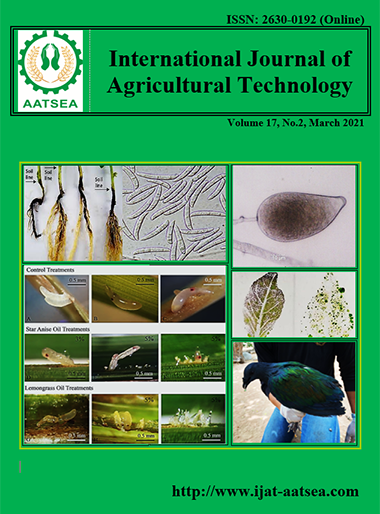Anthocyanin and polyphenol contents of Antidesma thwaitesianum Müll. Arg. berry juice being stabilized by protein matrices
Main Article Content
Abstract
The berry juice of Antidesma thwaitesianum Müll. Arg. has been recognized as a rich source of anthocyanin, proanthocyanidin and polyphenol. However, the rapid decrease in polyphenol contents, antioxidant activity and sensory perception during storage hamper its development as health-promoting products. To circumvent this problem, we introduced a method called anthocyanin-protein sorption (APS) to retard polyphenols depletion. The AT berry juice was adsorbed on five different proteins (soy protein isolate (SPI), whey protein isolates (WPI), soybean powder (SBP), black bean powder (BBP), and red bean powders (RBP)), and the matrices obtained after the sorption were evaluated for anthocyanin, proanthocyanidin and total phenolic content along with the antioxidant activity. After four-week storage, all of polyphenol content and the antioxidant activity of AT berry juice decreased dramatically whereas those of anthocyanin-protein matrices were slightly declined (5-21%) over twenty-four-week observation. As protein investigation soy protein isolate (SPI) was most effectively stabilized AT berry juice polyphenols with 5-8% decrease in anthocyanin, proanthocyanidin and total phenoliccontents
Article Details

This work is licensed under a Creative Commons Attribution-NonCommercial-NoDerivatives 4.0 International License.
References
Abou-Samra, R., Keersmaekers, L., Brienza, D., Mukherjee, R. and Macé, K. (2011). Effect of different protein sources on satiation and short-term satiety when consumed as a starter. Nutrition Journal, 10:139.
Butkhup, L. and Samappito, S. (2008). Analysis of anthocyanin, flavonoids, and phenolic acids in tropical bignay berries. International Journal of Fruit Science, 8:15-34.
Ding, S., Jiang, H. and Fang, J. (2018). Regulation of Immune Function by Polyphenols. Journal of Immunology Research, 1-8.
Ferruzzi, M. G., Bordenave, N. and Hamaker, B. R. (2012). Does flavor impact function Potential consequences of polyphenol-protein interactions in delivery and bioactivity of flavanols from foods. Physiology & Behavior, 107:591-597.
Grace, M. H., Guzman, I., Roopchand, D. E., Moskal, K., Cheng, D. M., Pogrebnyak, N., Raskin, I., Howell, A. and Lila, M. A. (2013). Stable Binding of Alternative Protein-Enriched Food Matrices with Concentrated Cranberry Bioflavonoids for Functional Food Applications. Agric. Food Chemistry, 61:6856-64.
Hansakul, P., Dechayont, B., Phuaklee, P., Prajuabjinda, O., Juckmeta, T. and Itharat, A. (2015). Cytotoxic and antioxidant activities of Antidesma thwaitesianum Müll Arg. (Euphorbiaceae) fruit and fruit waste extracts. Tropical Journal of Pharmaceutical Research, 14:627-634.
Kassem, M., Hashim, A. N. and Hassanein, M. H. (2013). Bioactivity of Antidesma bunius leaves (Euphorbiaceae) and their major pheolic constituents. European Scientific Journal, 9:217-228.
Kukongviriyapan, U., Kukongviriyapan, V., Pannangpetch, P., Donpunha, W., Sripui, J., Sae-Eaw, A. and Boonla, O. (2015). Mamao pomace extract alleviates hypertension and oxidative stress in nitricoxide deficient rats. Nutrients, 7:6194-6179.
Lee, J., Durst, R. W. and Wrolstad, R. E. (2005). Determination of total monomeric anthocyanin pigment content. Journal of AOAC International, 88:1269-1278.
Lim T. K. (2012). Edible medicinal and non-medicinal plants fruits ISBN 9400740530, 9789400740532. New York: Springer, 4:10-23.
Mahomoodally, F. M., Subratty, A. H., Gurib-Fakim, A. and Choudhary, M. I. (2012). Antioxidant, antiglycation and cytotoxicity evaluation of selected medicinal plants of the Mascarene. Complementary and Alternative Med, 12:1-12.
Mungkhunthod, S., Senggunprai, L., Tangsucharit, P., Sripui, J., Kukongviriyapan, U. and Pannangpetch, P. (2016). Antidesma thwaitesianum Pomace Extract Improves InsulinSensitivity Via Upregulation of PPAR-Ȗ in High Fat Diet/Streptozotocin-Induced Type 2 Diabetic Rats.; KKU Research Journal, 21:63-76.
Pengkumsri, N., Chaiyasut, C., Saenjum, C., Sirilun, S., Peerajan, S. and Suwannalert, P. (2015a.) Physicochemical and antioxidative properties of black, brown and red rice varieties of northern Thailand. Food Science and Technology (Campinas), 35:331-338.
Pengkumsri, N., Chaiyasut, C., Sivamaruthi, B.S., Saenjum, C., Sirilun, S. and Peerajan, S. (2015b). The influence of extraction methods on composition and antioxidant properties of rice Bran oil. Food Science and Technology (Campinas), 35:493-501.
Poontawee, W., Natakankitkul, S. and Wongmekiat, O. (2016). Protective effect of Cleistocalyx nervosum var. paniala fruit extract against oxidative renal damage caused by cadmium. Molecules, 21:133.
Prior, R. L., Fan, E., Ji, H., Howell, A., Nio, C., Paynef, M. J. and Reed, J. (2010). Multi-laboratory validation of a standard method for quantifying proanthocyanidins in cranberry powders. Journal of the Science of Food and Agriculture, 90:1473-1478.
Puangpronpitag, D., Areejitranusorn, P., Boonsiri, P., Suttajit, M. and Yongvanit, P. (2008). Antioxidant activities of polyphenolic compounds isolated from Antidesma thwaitesianum Müll. Arg. seeds and marcs. Food Science and Technology, 73:648-653.
Puangpronpitag, D., Yongvanit, P., Boonsiri, P., Suttajit, M., Areejitranusorn, P. and Na, H. K. (2011). Molecularmechanism underlying anti-apoptotic and anti-inflammatory effect of Mamao (Antidesma thwaitesianum Mull. Arg.) polyphenolics in human breast epithelial cells. Food Chemistry, 127:1450-8.
Roopchand, D. E., Grace, M. H, Kuhn, P., Cheng, D. M., Plundrich, N., Poulev, A., Howell, A., Fridlender, B., Lila, M. A. and Raskin, I. (2012). Efficient sorption of polyphenols to soybean flour enables natural fortification of foods. Food Chemistry, 131:1193-1200.
Roopchand, D. E., Krueger, C. G., Moskal, K., Fridlender, B., Lila, M. A. and Raskin, I. (2013). Food-compatible method for the efficient extraction and stabilization of cranberry pomace polyphenols. Food Chemistry, 141:3664-3669.
Singleton, V. L. and Rossi, J. A. (1965). Colorimetry of total phenolics with phosphomolybdic-phosphotungstic acid reagents. American Journal of Enology and Viticulture, 16:144-158.
Sireeratawong, S., Vannasiri, S., Nanna, U., Singhalak, T. and Jaijoy, K. (2012). Evaluation of acute and chronic toxicities of the water extract from Ziziphus attopensis Pierre. ISRN Pharmacol, 789651:2090-5165.
Tuyoien, T. and Itharat, A. (2010). Biological activities of Antidesma thwaitesianum Muell. Thai J Pharmacol, 32:126-128.
Yousef, G. G., Grace, M. H., Medina, J. L., Neff, S., Guzman, I., Brown, A. F., Raskin, I. and Lila, M. A. (2014). Concentrating immunoprotective phytoactive compounds from fruits and vegetables into shelf-stable protein-rich ingredients. Plant Foods for Human Nutrition (Dordrecht, Netherlands), 69:317-324.


